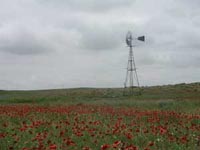Resource Library
Plant of the Week: Indian Blanket (Blanket Flower)
The University of Arkansas System Division of Agriculture does not promote, support or recommend plants featured in "Plant of the Week." Please consult your local Extension office for plants suitable for your region.
Plant of the Week
Blanket Flower, Indian Blanket
Latin: Gaillardia pulchella

My horticultural hero, L. H. Bailey, commented in one of his many books something to the effect that the nice thing about being fascinated with plants was that you can find something interesting no matter where you go.
Over Memorial Day weekend, my brother Ron and I decided to visit the highest place in Oklahoma, the 4,973-foot Black Mesa in the Cimarron County, the most westerly county in the state.
I’d heard all the comments of "Why? There is nothing there" I could stand by the time we left. We hadn’t gone far when the wildflowers began to make an appearance, including the beautiful Blanket Flower (Gaillardia pulchella). I’ve made a number of wildflower excursions before, but this was a special season in the Old West.
This blanket flower is an annual, growing about 2 feet tall with jagged ray petals circling a central brownish-purple cone of disk florets. Gaillardia is a member of the daisy family, so each petal is a flower. The showy ray flowers are orangish-red and marked with a broad band of yellow at the tip. Each petal has serrated, tooth-like incisions as if trimmed by pinking shears. The bloom period lasts for four to six weeks during late spring and early summer.
The beauty of blanket flower is not in the individual blossom, but in the mass display. Acres of blanket flowers paint the bottoms and sides of some of the shallow, open valleys red, accounting for the common name.
Ranchers in the region no doubt consider them weeds, but, oh, such pretty weeds. Because they grow so easily from seed, they are often added to wildflower mixes and used for roadside plantings in areas that aren’t too wet during the winter.
The name Gaillardia was assigned to the 14 species in the genus in 1786 by a French botanist to commemorate a French magistrate and patron of botany, Gaillard de Charentonneau. The species epitaph is fitting, translating from Latin to simply mean "pretty."
Gaillardia pulchella is found in most of the eastern states, including Arkansas. It grows primarily in dry or gritty soils prone to summertime drought. In Arkansas, its native range is limited to the southwestern counties, but it has been used in roadside wildflower mixes, so can now be seen in other parts of the state.
Blanket flower seeds are readily available from mailorder sources. It’s easy to grow in the garden, either sewing the seeds directly in early spring where they are to grow or starting seeds early and transplanting seedlings to the garden.
If it’s started inside, transplant the seedlings to the garden as soon as the weather permits, but before they start to send up a flower shoot. If flowers are present, cut them off and force the plant to grow new ones. Otherwise, the transplant will never become established and make a nice display.
Perennial gaillardias, selections of G. x grandiflora were created by crossing G. aristata with G. pulchella. These are probably better garden plants than the annuals, but as perennials they tend to be short lived. They can be grown from seed, propagated by springtime division or grown from spring cuttings.
By: Gerald Klingaman, retired
Extension Horticulturist - Ornamentals
Extension News - June 10, 2005
The University of Arkansas System Division of Agriculture does not maintain lists of retail outlets where these plants can be purchased. Please check your local nursery or other retail outlets to ask about the availability of these plants for your growing area.